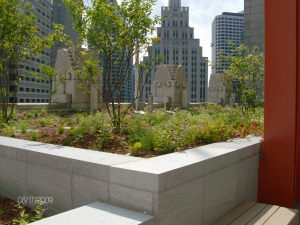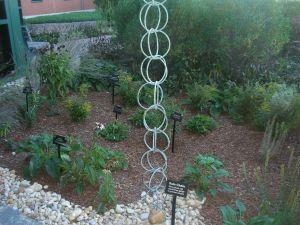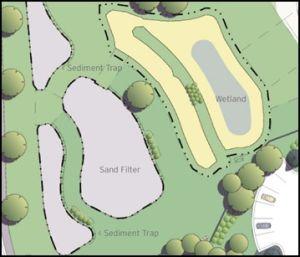Stormwater Management Practices at EPA Facilities
EPA implements sustainable stormwater management, also called low impact development (LID) or green infrastructure, at its facilities. Sustainable stormwater management focuses on reducing runoff and improving water quality. LID practices help maintain natural hydrologic cycles through site grading, vegetation, soils and natural processes that absorb and filter stormwater onsite. They also help minimize erosion, flooding and water pollution downstream from EPA facilities.
Following are some of the green infrastructure and LID practices EPA uses to reduce stormwater runoff and pollution:
- Green Roofs
- Rain Barrels and Cisterns
- Permeable Pavements
- Bioretention Areas
- Vegetated Swales/Dry Swales
- Curb and Gutter Elimination
- Vegetated Filter Strips
- Sand and Organic Filters
- Constructed Wetlands
- Riparian Buffers
Green Roofs

The green roof on EPA’s New England Regional Office in Boston
“Green” roofs are covered with vegetation to enable rainfall infiltration and evapotranspiration of stored water. A green roof can also reduce the effects of atmospheric pollution, reduce energy costs, decrease the “heat island” effect and create an attractive environment.
- EPA incorporated green rooftops at its New England Regional Office in Boston. Rainwater is collected from the 4th, 5th and 17th floor rooftops, stored in cisterns and distributed by a solar-powered pump to irrigate the green roof.
- The A.W. Breidenbach Environmental Research Center in Cincinnati, Ohio, has an 8,000-square-foot green roof. The roof provides 1,000 cubic feet of water storage, enough to retain the rainfall from a 1.6-inch storm.
- EPA also has green roofs at its offices in Arlington, Virginia, and Denver, Colorado, as well as the Atlantic Ecology Division Laboratory in Narragansett, Rhode Island.
Rain Barrels and Cisterns
Rain barrels and cisterns harvest rainwater primarily from rooftops for reuse. Rain barrels are placed at roof downspouts, and cisterns store rainwater in larger volumes in tanks for use in non-potable applications such as toilet flushing.
- EPA Headquarters in Washington, D.C., has installed six 1,000-gallon cisterns that are used to irrigate Headquarters’ landscaping as part of an LID demonstration project.
Permeable Pavements
 Permeable parking lot at EPA’s Region 2 Laboratory in Edison, New Jersey
Permeable parking lot at EPA’s Region 2 Laboratory in Edison, New Jersey
Permeable surfaces, unlike impermeable surfaces such as asphalt or concrete, allow stormwater to infiltrate through porous surfaces into the soil and groundwater. EPA parking lots, driveways or sidewalks include pervious concrete, porous asphalt, pervious interlocking concrete pavers or grid pavers.
- EPA installed a 300,000-square-foot permeable pavement parking lot with porous asphalt, porous concrete and pervious interlocking paver blocks at its Region 2 Laboratory in Edison, New Jersey, to research the effects of different permeable surfaces on stormwater runoff.
Bioretention Areas

Rain garden and rain chains at EPA’s Environmental Science Center in Fort Meade, Maryland
Bioretention areas are shallow, landscaped depressions that allow runoff to pond in a designated area, then filter through soil and vegetation. Small-scale bioretention areas are also known as rain gardens.
- EPA employees at the Environmental Science Center in Fort Meade, Maryland, helped construct a rain garden with native grasses and wildflowers. Rain chains guide rainwater from the roof gutter to the garden.
Vegetated Swales/Dry Swales
Swales are drainage paths or vegetated channels used to transport water. They can be used in small drainage areas with low runoff instead of underground storm sewers or concrete open channels. Swales help slow runoff, facilitate infiltration and filter pollutants as runoff flows through the system.
Curb and Gutter Elimination
Curbs and gutters collect and transport runoff quickly to a stormwater drain without allowing for infiltration or pollutant removal. Eliminating curbs or adding curb cuts allows runoff to be directed into pervious areas and filtered through LID features. Swales can also be used to replace curbs and gutters as a way to convey runoff.
Vegetated Filter Strips
Vegetated filter strips are bands of dense vegetation through which runoff is directed. They are best for gently sloping areas, where channelized flow is not likely. Filter strips may treat runoff from roads and highways, roof downspouts, very small parking lots and impervious surfaces.
Sand and Organic Filters

Schematic of sand filter and constructed wetland at EPA’s Region 7 Office in Lenexa, Kansas
Runoff directed to these filters infiltrates through a sand bed to remove floatables, particulate metals and pollutants. They are typically used as a component of a treatment train to remove pollution from stormwater before discharge to receiving waters, to groundwater or for reuse.
- EPA’s Region 7 Office in Lenexa, Kansas, has vegetated swales, sand filters and a constructed wetland that treat and infiltrate 100 percent of the stormwater on the 30-acre property.
Constructed Wetlands
Constructed wetlands mimic natural wetlands. They capture and filter stormwater and create diverse wildlife habitat. They are designed to contain standing water on the surface or water saturated just below the soil surface.
Riparian Buffers
A riparian buffer is an area along a shoreline, wetland or stream where development is restricted or prohibited. The primary function is to physically separate and protect the aquatic area from future disturbance or encroachment. A properly designed buffer can act as a right-of-way during floods, sustaining the integrity of aquatic ecosystems and habitats.
For more information, visit the EPA Office of Water green infrastructure page.
